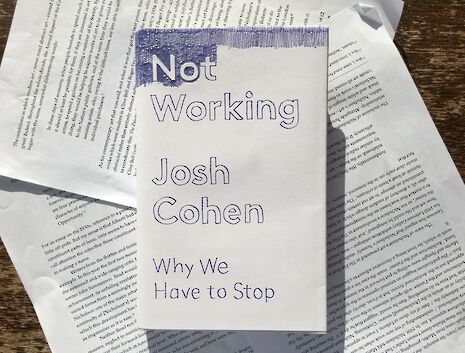Work and its woes
John Rattray discusses psychoanalyst Josh Cohen’s convincing case for why we need time out

Josh Cohen is a psychoanalyst. This comes out in the first sentence of his new book, Not Working: Why We Have to Stop, a discussion of our relationship with work, and an eloquent case for the merits of taking time to not do it. It’s a curious beginning for a book which is adamant that our work shouldn’t define us, but a necessary one all the same. The immediacy of Cohen’s disclosure tells of a need to quell an equally immediate question: why ought we listen to you and what you think about work?
It’s a valid question, and Cohen’s answer rises to the challenge well, erasing any charges of contradiction on the way. The psychoanalyst’s working day is framed by other people’s working days, which he finds often begin with dread and end with exhaustion. While Cohen acknowledges that this might mean his view of “modern work as plagued by stress, enervation and fatigue” is somewhat exaggerated, it remains that he’s unusually attuned to “the discontents of work” and the symptoms of that discontent. Speaking more generally, Cohen argues that psychoanalysis is, as a discipline, ideally placed to deal with the existential questions that work, and stopping it, raise. For him, psychoanalysis is key in recognising the fact that “not working is at least as fundamental as working to who and what we are”, and interrogating why it is that we’re so reluctant to acknowledge that fact.
“No sooner do we come to a stop than voices assail us from without and within, demanding we start again”
The proof of our fundamental desire to not work is, Cohen claims, all around us: it comes in the form of gravity and Newton’s first law of motion. Elegantly transposing Newton’s law from the outer world to the inner, Cohen puts it to the reader that, like all other physical entities, “we can only move so far and do so much before we are forced to stop.” This much seems reasonable. And yet, as he points out, everywhere today we find evidence to the contrary, either in our unwillingness to accept inactivity as worthwhile or the glorification of obscene working hours. In answering why this is, Cohen suggests we look to Freud for our answers.
Freud’s concept of the ‘ego ideal’ (the voice in us that motivates us to get a first, go to that lecture, and go to the gym) coupled with the ‘superego’ (a more stern moral imperative than calm, encouraging TED talk) makes sure “that most of us experience some level of anxiety regarding our limits”. This anxiety is known to most and students are no exception – particularly here in Cambridge. With a (psychoanalytic) perceptiveness that one comes to enjoy throughout the book, Cohen articulates the self-reproach that prevents us from not-working: “no sooner do we come to a stop than voices assail us from without and within, demanding we start again.”
“In each chapter, Cohen first offers a historical and psychoanalytic account of the typology”
Cohen is clear that we should resist these voices, amplified as they are by our culture of “permanent compulsion towards frenetic activity and distraction.” He’s clear, then, that we have to stop. The natural questions of how and why are addressed across the book’s four chapters, each of which shows us what stopping, in its different manifestations, could do for us.
The first two chapters deal with those who have succumbed to the forces of the psyche’s internal gravity: the burnout and the slob. The other two engage with those who, seeking to escape work and all its worldly demands, recede into the imagination: the slacker and the daydreamer. In each chapter, Cohen first offers a historical and psychoanalytic account of the typology. These erudite, enjoyable introductory sections are followed by write-ups of cases that Cohen has encountered in his consulting room. Here erudition is supplanted by a sensitive directness, apparent in both Cohen’s own charming transparency regarding his limitations, and the frank retelling of real lives and troubles, the poignancy of which speak for themselves.
“Neither diluted nor overly complex, a topic which might otherwise be dense and difficult to penetrate becomes light, almost easy, though always retaining a sense of importance”
Less successful are the concluding sections of each chapter which present, in Cohen’s words, “biographical sketches” of artists who “channeled feelings of indifference, slothful indulgence, withdraw and boredom into remarkable cultural achievements”. Though these passages are certainly interesting – dotted, like the rest of the book, with learned references and refreshing insight – their enjoyment is tainted by a lingering sense of their somewhat strained relevance, and their largely speculative nature. It’s hard not to feel that, while they may brilliant, if slightly digressive, pieces of art history or retrospective psychoanalysis, they might be better as precisely that – works in their own right rather than bits of Cohen’s larger argument. They take more than they give, detracting and confusing from his case for not working rather than bolstering and clarifying it. This is not least because the artists in question (Andy Warhol, Orson Welles, Emily Dickinson and David Foster Wallace) did work – and rather a lot.
It’s here that one of the book’s central issues appears: the definition of work. This comes up when Cohen explains his choice of these artists. Posing the question “what do artists do?”, he answers that, insofar as the thing they produce doesn’t impact reality in the same way other work does, artists “do little in the way of concrete action”. Perhaps. But while it’s true that art is a different sort of work – no one would claim, after all, that sculpting is the same sort of work as stockbroking – Cohen oversimplifies things a bit. It’s hard, for example, to accept his claim that “the creative act consists, paradoxically, in sustaining the inactive state.” The artists Cohen chooses don’t match up with his definition of stopping as an intransitive verb, to “just stop”, and in doing so protest “against the tyranny of action.” In his own words, they “channeled” the feelings associated with inactivity into art. To play at Cohen’s game, the verb ‘to channel’ means to “direct towards a particular end or object”; and this, surely, requires some action, be it physical or mental.
To get caught up in semantics is to do Cohen a disservice. Not Working remains an important, often fascinating, intervention in our culture of work and activity, in which time is scarce and the idea of completely unoccupied time a foreign, even laughable one. Though assuredly not a self-help book, Not Working is, in a way, helpful. Cohen offers a much-needed framework – at once historical, philosophical and psychoanalytic – with which we can begin to better understand our relationship with work; and, more importantly, begin to open ourselves to the idea of inactivity. Moreover, Cohen does all this in eminently readable and enjoyable prose.
Neither diluted nor overly complex, a topic which might otherwise be dense and difficult to penetrate becomes light, almost easy, though always retaining a sense of importance. We really don’t have to work to read Not Working. But if we agree with Nathaniel Hawthorne that “Easy reading is damn hard writing” then Cohen assuredly has.
 Comment / Plastic pubs: the problem with Cambridge alehouses 5 January 2026
Comment / Plastic pubs: the problem with Cambridge alehouses 5 January 2026 News / Cambridge academics stand out in King’s 2026 Honours List2 January 2026
News / Cambridge academics stand out in King’s 2026 Honours List2 January 2026 News / Cambridge businesses concerned infrastructure delays will hurt growth5 January 2026
News / Cambridge businesses concerned infrastructure delays will hurt growth5 January 2026 News / AstraZeneca sues for £32 million over faulty construction at Cambridge Campus31 December 2025
News / AstraZeneca sues for £32 million over faulty construction at Cambridge Campus31 December 2025 Interviews / You don’t need to peak at Cambridge, says Robin Harding31 December 2025
Interviews / You don’t need to peak at Cambridge, says Robin Harding31 December 2025










